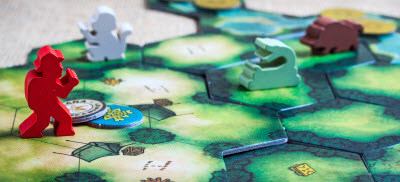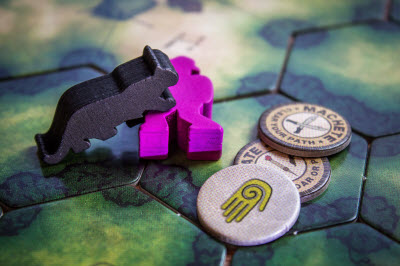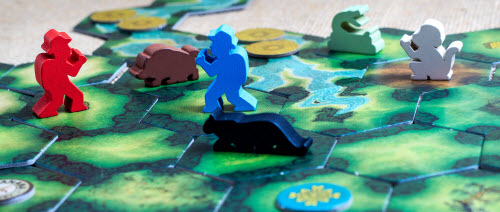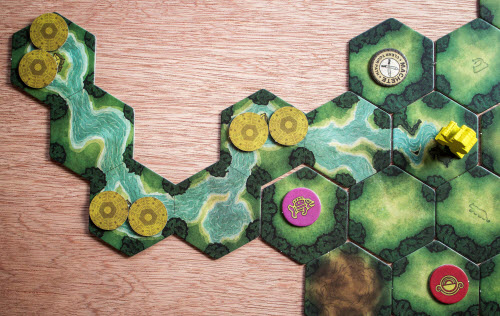I often hear people ask game designers if they pick a mechanic or a theme first. With Relic Expedition, I picked both the expanding board mechanic and the jungle exploration theme before doing any prototyping. Development was a constant back and forth between mechanics and theme. The most interesting example of this was deciding how much information should be public, private, and hidden. To illustrate this back and forth, there were three major changes I made throughout development:
#1. How Are Tiles Revealed?
Relic Expedition is a jungle exploration game where players explore an unknown area searching for hidden relics from a lost civilization. The board starts small, and new tiles are revealed as players explore. In many games with expanding boards, players must take an action of some kind to reveal a new tile. I experimented with that briefly, but it did not feel right for Relic Expedition. This would have made moving to an unknown space essentially double the effort of moving to a known space (one action to reveal, one to move). This bogged down exploration, and it did not produce the feeling of running through the jungle on an adventure.

So, I decided the jungle would need to be revealed as players moved. At first I thought players could move to an empty space and then reveal a tile in that space. This felt thematic, but it made the risk and the reward of movement too extreme. (You would either find a relic right at your feet or find a panther right in your face.) It would also have removed any decision about where to move in exploring: you would move to any empty space and simply hoped for the best. This just did not work mechanically.
I then considered revealing tiles in adjacent spaces. This meant that players would know what was on a tile before they moved on to it, giving players a reason to move to one tile instead of another. The thematic feeling of discovery and of danger lurking around every corner remained, but it wasn’t so extreme. It was much less dangerous now than a real jungle expedition would be thematically, but it seemed necessary for it to be a fun game.
#2. How Are Supplies Dropped?

Could have used a trap here too…
Players can drop supplies they don’t need on the jungle floor. Since thematically one explorer wouldn’t know what another explorer had found or dropped in the jungle, all the supplies were originally placed on the board face down and players looked at them privately when they reached the space. Players originally could even have placed a trap face down on the board, which would trap any player who looked at it later.
While hidden supplies made sense theme-wise, once again it just did not work mechanically. Players needed plenty of choices to make, and hidden supplies (with the possibility of traps) meant that it was never worth the risk for one player to walk across to a space with supplies. I resisted this for a while because I did not want to lose the traps, but I eventually conceded and followed the game where it wanted to go. Now, players always drop supplies on the board face up.
#3. How Are Relics Revealed?
Some of the tiles bring relics in when revealed. Players win by collecting four matching relics (either all the same color or with all the same symbol), and there are six relics of each possible match. Originally, these relics came into play face down, and players could look at them privately when they moved to the space. This was inconsistent with the change I had previously made to supplies, but I was pretty sure I wanted the relics to be kept secret.
As I continued to test the game, however, the inconsistency between relics (face down) and supplies (face up) on the board grated on me. I also started to realize ways that turning relics face up could give players important information to make more interesting decisions. Players would know what relics other players were collecting. A player could intentionally pick up a relic that another player needed just to hinder them, for example. A player would also know if other players had picked up some of the relics they themselves were collecting, and could then decide to change his goal. After much inner turmoil, though,I relented and changed the rules so that relics behaved just like supplies.
The game played much better with relics placed up on jungle tiles, but I immediately hit a problem with the feature boards. Relic Expedition has three large feature boards (a river, a cave, and a mountain), and each feature board requires a special supply to access it. (For example, a headlamp is required to enter the cave.)
These features have multiple relics on them, and the game changed drastically when those relics were placed face up. I almost reverted back to placing all relics down, but I decided to compromise with an inconsistency: relics would come into play face up on jungle tiles and face down on the features.
I hated this inconsistency, but I wanted to see how it played. It felt thematic, and it worked mechanically. I kept working to come up with a way to eliminate or smooth over the inconsistency, though, and it was a comment by a playtester gave me the answer. Standing next to a river space with relics on it, he asked, “Can I flip these relics over since I’m next to them?”
I looked at him and realized immediately that I had my answer.
“Yes,” I said, slightly changing the rules in the middle of the test, “absolutely. You always reveal things that are adjacent to any explorer.” The inconsistency was gone with just a very small change, and all three of these things (tiles, supplies, and relics) were united: everything is revealed when it is on a space adjacent to an explorer.
I started designing Relic Expedition with one underlying premise: you can see anything on the same space as you. At the end of development, I had changed it to this: you can see anything on a space adjacent to any explorer. This made more information public than I initially expected because of the theme, but it gave players a lot more usable information to manage the probabilities in the game and make interesting decisions. The last part was that I still felt the need to explain that change thematically, which was easy enough to do after getting the gameplay where I wanted it: the explorers have clearly all tapped into each other’s communication lines, which explains why there is so much public information on the board. Once I brought the mechanics back in line with the theme, I knew we were on the right track.

“Chhkkkk, base camp, I think I just saw a panth..AHHHHH!!!…chhkk….”
![]()
Randy Hoyt was gracious enough to offer up an exclusive designer journal for Relic Expedition. He is a game designer and co-owner of the Foxtrot Games. If he’s not off in the jungles of game design, Randy can be reached via email or on Twitter.
Also, if you’re a game designer looking for opportunities to share your design stories, feel free to contact ryan@cardboardrepublic.com.
Photo Credits: Relic Expedition pictures by Scott King.

